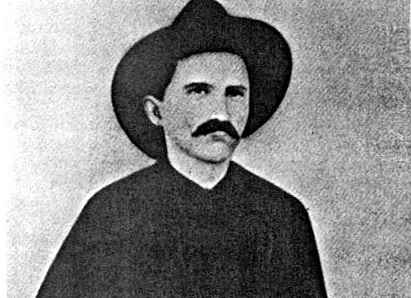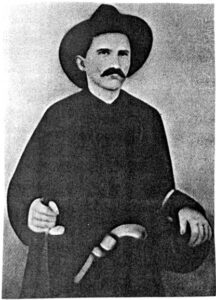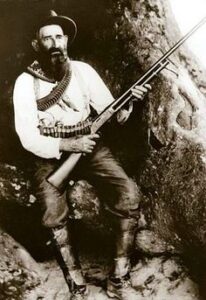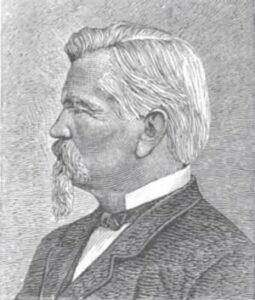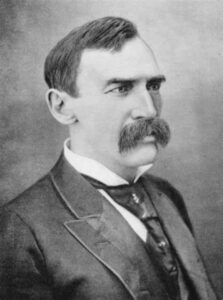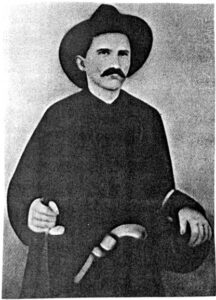In part four of the Hatfield and McCoy Feud gets serious as the States of Kentucky and West Virginia prepared for war against each other. Things are about to get more violent in the feud as the families are now at a tipping point. This is considered to be one of the most violent sections of the feud. Also entering into the fray was another controversial character into the Feud by the name of Frank Phillips.
The New Year’s Massacre
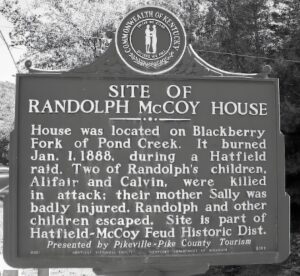
By this point at the end of 1887, Randolph McCoy had lost three sons and a brother to the Hatfield family. Justice was not being served upon their murders through the courts. His attempt to gain justice through political actions would turn into more tragedy for the family.
New Year’s Night 1888 is historically considered to be the beginning of the peak of the violence between the two feuding families. Cap Hatfield, Anse Hatfield’s son, and Jim Vance, Anse Hatfield’s uncle, led a group of Hatfields to the McCoy family cabin and open fire in the middle of the night on the sleeping family. The cabin was then set on fire in an attempt to draw Randolph McCoy out into the open.
McCoy escaped however two of his children were shot and killed (Randolph’s son Calvin and daughter Allaphare) and his wife, Sarah, was beaten severely, with a skull fracture, and almost died of her injuries. The beating of Sarah is often assigned to Vance. The children and family members who escaped with Randolph McCoy suffered frostbite due to only being in their night clothing and was unprepared for the cold night. The family then moved to Pikeville in an attempt to end the night raids and for the safety of the family.
The Battle of Grapevine Creek 1888
The beginning of the battle started when Deputy Sheriff “Bad” Frank Philipps and his posse that included Bud McCoy and one of Randolph’s sons, James “Jim” McCoy were commissioned by the Kentucky State Govenor, Simon Buckner, to begin tracking Anse Hatfield and his group of men across the border into West Virginia. On January 10th, Philips arrested Cap Hatfield, Jim Vance was the first to die as he was killed resisting arrest in the wooded area. There are several who claimed that Vance was killed after the party, which included several McCoys, ran him down in the woods. Still others claim that Philips took the law into his own hands and killed Vance himself. In several raids, Philipps was able to capture more conspirators and three Hatfield supporters were killed in the attempts.
Jim Vance
Often seen as a loose cannon in the feud, it seems that Jim Vance was not the major player in the feud as many think. While he is historically at all of the major events of the dispute, he was not generally seen as an instigator but more of just a member of the group as a whole, as the Hatfields saw him as a loving Uncle. However, if you ask the McCoys, they saw Vance as a murderer who was mentally unhinged. Vance did become a Constable in 1870, and at the same time, he has been deemed an outlaw in Pike County, Kentucky. Like many of the Sheriffs and Marshalls of that time, it was not unusual to have a lawman be wanted by the law in the next state or County over from where they served. It is a very complex society in the Appalachians and very hard to actually grab a hold of those men of that time who can be both a Sheriff and called “Devil” or “Bad” or other names due to some of the actions that they took.
January 19, 1888 Kentucky and West Virginia Take Up Arms
Deputy Sheriff Frank Philipps and his posse found Anes and the other Hatfields waiting upon them at Grapevine Creek. The largest gun battle of the feud began, which has made the feud legendary, but the Hatfields were eventually rounded up and arrested. Deputy Bill Dempsey, who was a Hatfield supporter, was wounded and executed by Deputy Sheriff Frank Philipps on the scene after the Hatfields had surrendered. This battle claimed more than a dozen lives from both sides of the feud.
This had gotten to the point that the Governors of the states of West Virginia and Kentucky got involved in the conflict Kentucky Governor Simon B. Buckner sent his Adjutant General Sam Hill to Pike County to investigate how the situation could be calmed.
West Virginia State Governor, E Willis Wilson, demanded that the men be returned to the state of West Virginia as their capture was deemed illegal and not recognized by the state. Wison sued the state of Kentucky for the illegal arrest of the nine prisoners being held in Pike County and demanded reparations for the raids into the state of West Virginia. Wilson also sent troops to the border of West Virginia to prevent further raids across the Tug River.
In response, Buckner sent troops to the Kentucky border to prevent further retaliatory raids by either the troops or the Hatfields against the McCoys. In only twenty years since the Civil War, once again the troops from two states were facing one another.
August 24, 1888 Arrests
The Hatfields and their families were indicted for the murder of Allaphare McCoy and others for resisting arrest. Those listed in the indictments were the following:
Cap Hatfield
Johnson, known as “Johnse” Hatfield
Robert Hatfield
Elliot Hatfield
Ellison “Cottontop” Mounts
French Ellis
Charles Gillespie
Thomas Chambers.
Valentine “Uncle Wall” Hatfield
Doc D. Mahon
Pliant Mahon
“Bad” Frank Philipps
Was he an anti-hero or villain, well that depends on which side that you are taking with this feud? There are many stories of his time with wild women, alcohol, and excessive force. Still, there are others who view him as taking the actions necessary to reign in one of Tug River Valley’s most wanted gangs of criminals. At this time in history, the Appalachian Mountains were the Wild West before there was a Wild West. Very little law and order were established and it was not uncommon for families to take justice into their own hands. With Philipps actions to arrest the Hatfields, the United States Supreme Court had to make a ruling as there were two states involved.
Source Material
All the Dirty Details About the Hatfield-McCoy Feud of the Late Nineteenth Century
https://historycollection.com/all-the-dirty-details-about-the-hatfield-mccoy-feud-of-the-late-nineteenth-century/
Hatfield–McCoy feud
https://en.wikipedia.org/wiki/Hatfield%E2%80%93McCoy_feud
The Untold Truth Of The Hatfield-McCoy Feud
https://www.grunge.com/349890/the-untold-truth-of-the-hatfield-mccoy-feud/
The Bloody Feud of the Hatfields and McCoys
https://www.legendsofamerica.com/hatfields-mccoys/
What’s the Real Story Behind the Hatfield-McCoy Feud?
https://www.wideopencountry.com/hatfields-and-mccoys-feud-real-story/
5 Things Hatfields and McCoys Still Feud Over
https://tourpikecounty.com/5-things-hatfields-and-mccoys-still-feud-over/
Copyright and Other Information
Copyrighted through a Creative Commons License.
This work is licensed under a Creative Commons
Social Media Pages
Facebook
https://facebook.com/kytnliving
Twitter
https://twitter.com/KYTNLiving
YouTube
https://youtube.com/kytnliving
When we forget our past and who we are as a people, then we become who “they” say we are. ~~ David Sergent
I have attended the University of Kentucky. I have an Associates Degree from Hazard Community College and Technical School. I have also attended the University of Pikeville. I have taken several classes in Journalism as well as in the Appalachian History, Literature, and Sociology during my time at those schools.
I was born in Florida and grew up in Burdine, Kentucky. I have been married to David W. Sergent since May 4, 2013. I have two children and four grandchildren from a previous marriage. I currently live in Tennessee but my hope is to one day come back home to live in the beautiful mountains once more.


